“Weiss, you dumbass! Start making sense you rotten book, or you’re gonna be sorry! Maybe I’ll rip your pages out one-by-one, or maybe I’ll put you in the goddamn furnace! How can someone with such a big, smart brain get hypnotized like a little bitch huh?! Oh, Shadowlord! I love you Shadowlord! Come over here and give Weiss a big sloppy kiss, Shadowlord! Now pull your head out of your goddamn ass and START FUCKING HELPING US!”
Nier’s reception in 2010 was, well not great. It was marred by a few now infamous incidents which screamed “poor design” to some and left many feeling cold. On reflection it seems like Nier was destined to slide noiselessly into the background over here in the west, from first impressions it looks like another JRPG/ action adventure much in the vein of Bayonetta, but without the fanfares, flashy graphics and an almost nude protagonist. What really sealed the deal, turned away those who might have shown some interest in this understated title, was a video review by Justin McElroy who had an issue with Nier’s fishing mini-game. Okay, that was an understatement, the reviewer in question rage-quit over the inability to catch a fish and made a video to highlight how apparently broken it is. This “review” has been debunked well and truly by numerous sources now, and it’s not something I’m planning to go into depth here (the fact that I caught the fish within 30 seconds notwithstanding), what this reviewer, and many others, have missed is the thought and wit which has been poured into the design of Nier which make it an ambitious and intriguing title, something really very special.
I do believe that when you talk about Nier there is one thing you really need to address and that is the distinction between poor design and an ironic use of game mechanics to pay tribute to and critique other games. Lets get this straight, Nier is a game about games, a pastiche of the action-adventure/RPG genre and often more besides. To really appreciate what it has to offer you’ve got to be aware of at least some of the clichés it addresses, games it pays homage to and tropes it twists and borrows. Nier’s characters appear to be distillations of more recognisable gaming archetypes, aware of who they are and how they function. The crucial part with Nier though, after being concious of the decisions made they twist the formula, distorting the original image and creating something which feels fresh and sometimes dysfunctional, but in a functional way. At first glance you may recognise any of the characters from other Square games, or JRPGS more generally, but if you really get to know them you’ll see more evidence of Nier’s commentary at work.
In Nier you play the traditional unnamed protagonist, and by unnamed protagonist the game means it in the way Link was unnamed in the Legend of Zelda titles. You play as Nier, or “AntiHiro” or “Captain Rogue Hat” or whatever you fancy calling yourself, a muscle bound huntsman who is forced to do odd jobs and fetch quests in order to pay for the medication of his terminally ill daughter. He is single-minded and unyielding, he displays the truest dedication to his daughter and the company he keeps. Yet a moments through the game he openly expresses a will to murder everything in order to find the answers, to run people through with his sword rather than use his brain. Grimoire Weiss, your faithful companion and key to destructive dark magic attacks, is perhaps one of the most interesting characters I have encountered for a long time. He is introduced as an ancient magical tome, who holds immense power and secrets within his pages. Whilst the immense power (and the respect that it demands) is palpable through the extra abilities you gain when you are paired, it makes an often glaring absence when Weiss is forced to interact with the narrative. On many occasions Weiss is unable to provide anything more than a sarcastic quip or scathing retort when Nier is forced to act, his immense knowledge manifested in his irritable personality rather than valuable information. Weiss is more than a hovering weapon/ inventory management system, he also provides a witty and knowing commentary which invariably is the key to the game’s whole systems of pastiche and parody.
As I noted earlier, there are many elements within the game which could be lamented as bad design. Yet I would argue that the majority of these incidences are in fact knowingly done as part of the game’s overall commentary, they are intentional. Proving this to a sceptical audience is less than easy as many would find the fact that a game would be intentionally be made badly in order to prove a point, quite preposterous. For example Nier can sprint and jump at inhuman speeds, yet when it comes to climbing a ladder he move’s like an infant navigating an assault course. This is somewhat of a moot point as there are few climbing sequences in the game, however trying to argue that this is a commentary without any further evidence is difficult indeed. I would argue though, that the commentary that Weiss provides is one which often echoes that of the player. When undertaking seemingly pointless fetch quests Weiss will often remark that it is a simple waste of time when you consider the other, more important tasks at hand. This commentary, whilst not explaining or remarking upon all the seemingly bad design choices within the game, is the key fact which leads you to believe the game is decidedly knowing and purposeful, suggesting that there is more to it that first meets the eye.
Kainé is anything but a typical “action babe” style character, she is a more scantly clad Bayonetta with a foul mouth, leaping around the battlefield in her underwear shouting profanities and killing anything which gets in her way. For a Square Enix game, much attention was paid to Kainé’s use of verbal languages, but also to the type of enigma that she was. Having female characters who ware little is hardly a new feature within the action/ RPG genres, also, having them feisty and deadly is something Lara Croft nailed pretty early on. What is it about Kainé then which the game is less than forthcoming about? The suggestion maybe, that she is a hermaphrodite? Accounts on this are mixed as the game does nothing more than hint at this, many suspect that Kainé being corrupted by a male Shade had given her an ill-temperament and gentlemen parts. Others suggest that she was an outcast, foul-mouthed hermaphrodite that simply got possessed later on (the later game play through, whilst not making this point lucid, give more information). What this does mean however, that Kainé is taboo, she wears only her underwear to display her womanly traits, however a fleeting glimpse of what might be a bulge sows the seed of doubt. Such hyper feminised characters are a stable of the genre, but Kainé confuses that. She is outcast from her home village because of the fear of what she is and this, to a point is cast onto the player.
The final character is Emil. This poor boy is perhaps the most unlucky of a cast of pretty blighted characters. Even from first glance he seems to be the typical young sidekick character evident in such games. High-pitched voice, helpless and has whose personal constitution swings between ceaselessly optimistic and desperately sad within moments. Considering Emil was voiced by Julie Ann Taylor, who worked numerous Animé projects and games like Star Ocean, shows the need for Emil to be effeminate, spunky type. The combination of over-excitability and a high-pitched voice is what has often produced some of the most excruciatingly bad characters in computer game history, however, whilst Emil does take a little bit of getting used to, he actually has substance, he’s more than a high pitched voice. Emil is the glue which holds what is a terribly unpredictable party together, he also happens to be the most powerful character and ultimately saves everyone towards the game’s conclusion.
Some of the most memorable moments in Nier are not just provided by its characters, as a game it has often been described as a “mash-up” title, content to beg, borrow and sometimes steal elements from other titles in order to freshen gameplay. As I have mentioned earlier, Nier is a game about other games, a commentary about the fixed and arbitrary nature of genre titles and using other game mechanics to show this is very risky indeed. If you are not aware what Nier is trying to do, some of the design decisions within the game will seem confusing and broken and it would struggle to recover from it.
One of the games Nier parodies/ pays homage to most prolifically is Legend of Zelda Ocarina of Time. The subtly of such references do vary heavily throughout the game and range from something as simple as a camera movement to a sound effect right the way through to a whole dungeon which produces a meta-commentary on the the arbitrary nature of the puzzles and narrative of Action/Adventure /RPGs more generally. Whilst the references are littered throughout the game, the sequence where they manifest themselves most significantly is to be found relatively early on. You stumble across a strange desert village called Facade where the locals speak an unfamiliar tongue, wear strange masks and live by a mind-bogglingly bureaucratic rule system (Facade – Gettit?). After having found the king has recently died of the strange disease which has infected your daughter you learn that the Prince has gone missing on a quest to find the king’s mask so he can rule the village. The royal advisor and the village guards realise that because of the many rules which govern them, they cannot attempt to mount a rescue mission. It transpires that you are the only one who can save the Prince so you are led to the dungeon across the desert by one of the local folk and left to get on with it.
You soon learn that the dungeon is governed by similarly convoluted system as the people of Facade and the temple contains a series of puzzles which rule that you cannot use a particular move, magic or attack in each one. These do produce some interesting problem solving incidences, but as soon as you realise what you can and cannot do they become unbelievably easy. In one or two incidences it is actually possibly to “cheat” the puzzles, by which I do not mean, use the moves you’re forbidden to, but more simply, just bypass the entire puzzle completely. Initially I felt that by cheating the puzzles I felt cheated, but considering the ease which you could do it if you know how throws another light upon Nier’s prolonged commentary. Have you every stopped to think about dungeons in games? Do the puzzles present even make a shred of sense? I know this often isn’t the point, the idea is that they are a puzzle, but the construction is often so arbitrary the ludic elements begin show too heavily, compromising the world they’re contained in. That is exactly what happens in Nier, it is even remarked by the characters that they’re not happy about playing by these strange enforced rules, but they have to play the game to win. To top this off though, to hit home at what the entirety of that section was jabbing at/ paying homage to, when you complete the dungeon you are treated to familiar moment taken from any number of Legend of Zelda games, it’s a moment which is quite delightful but also an admission of Zelda’s heritage being part of the game.
If I was to tell you that Nier has moments which borrow from Shmups or some Isometric dungeon crawler then you might struggle to conceive how Nier even implements it, let alone see how it might make the gameplay richer at times. The Shmup/ Bullet Hell element of Nier is one of the most interesting and I would consider the most significant. Most enemies posses the ability to use dark magic attacks, these most frequently manifest themselves as red spheres which are fired at you in varying patterns and density. When you encounter a room with magic spewing enemies it is possible for the entire screen to be covered in projectiles making it almost impossible to doge, an Ikaruga-style moment of panic. Thankfully, Nier is considerably more forgiving than most Shmups in that you’re able to deflect or block most magic attacks if you time things correctly. Traversing one of Nier’s many Bullet Hell rooms is visually appealing and pleasantly challenging, forcing you to change you normal plan of attack, promoting timing, precision and a good sturdy pair of balls. Towards the later end of the game this element becomes more prolific at points and sadly, Nier leans on it too heavily to provide challenges which appear impossible unless you’ve mastered the techniques needed.
The isometric view implemented for a section of dungeon crawling is perhaps the most contentious use of another borrowed gameplay mechanic, not specifically because I believe it was done badly, but because of what a risk they were taking by using it. With the majority of isometric dungeon crawlers, the element which is lamented most is poor camera/viewing angles and cramped environments. Not finding some loot because you simply haven’t (or can’t) rotate the camera a few degrees to shed some light on an unexplored area of a room is an infuriating one. Nier is not bothered by that, in fact it hopes the player has experienced this. In one dungeon section within Nier you are forced to play using an isometric view, through rooms full of boxes, pillars and other, smaller rooms. At times the visibility during this section is so bad that it is actually funny, you really cannot see a thing! And to progress to the next room? It’s the hunt for one key after another. This hunt though whilst starting easy becomes very tricky when you realise you cannot see the next one needed to progress. The solution is devastatingly simple, rotate the camera, yet it’s not something that was immediately apparent (to me at least) and after searching for a key for 5 minutes only then to finding it was hidden not in box or as a drop, but rather by the game’s poor viewing angle. In my mind this is bad design, but it’s so intentional and so knowing that this sequence became one of the most comical during the game, I laughed when I realised where the key was, I laughed when I lost myself behind another box. Even with being able to rotate the camera, you’d have to be spinning it all the time in order to keep Nier in view.
Comedy behind that sequence aside we do begin to discover where Nier does sometimes suffer. What also came from the implementation of the Isometric view was that combat became a lot more difficult, whilst this could also be seen as intentional the sequence itself went on for far to long. Things that were witty at first initially threatened to become as infuriating as what they were trying to critique. That is a consistent problem with Nier if you’re willing to consider it’s bad design choices are as purposeful as the good ones, when the novelty or comic effect wears off you’re left with something which wears its flaws on its sleeve.
The RPG elements it critiques could be see as the ones which it is most harsh on at times. The most infamous moments in Nier are it’s seemingly pointless and often infuriating side-quests. Considering Nier’s world, whilst not Linear, is not the biggest or most comprehensive, makes it hardly the best place for fetch-quests to take place. The three open world areas which are linked to Nier’s village, whilst large, contain little and it serves primarily to link you to the dungeons. You can go “hunting”, foraging or slay some large Boar or Shade, only then to return to the village and receive a reward which is never worth the time. I would argue that Nier does not want you to undertake it’s side quests though, in fact I felt that it laughed at me for trying. As hard to swallow as this argument may be, there is enough within the games design to suggest it is a convoluted and over-elaborate part of its commentary. The first thing that might suggest this is through Weiss’ snide remarks when you undertake the relatively pointless quests, whilst not conclusive evidence, it made me question it myself. When you then consider the return on fetch-quests compared with collecting drops and selling choice items is no competition. I would suggest that Nier makes fetch-quests so unrewarding it inadvertently insults the player through what it offers as a “reward”. I’ve played through the game the first two times and yet found no need to conduct a fetch-quest that wasn’t a story related one.
Nier is a game that drops a lot, it has around 50 different raw materials around 30 weapons, not to mentions “words”, the system used to upgrade weapons and magic and some other seemingly miscellaneous stuff. There is a weapon upgrade system which does necessitate much of the drops, however in most incidences you need such a high quantity of the materials or they’re so rare, unless you’re a completionist, you’ll put off the task of upgrading the weapon until later. But Nier is constantly providing you with new weapons the upgrade system strikes as a bit unnecessary. Aside from the two incidences where you have to upgrade, it was something I ignored with my play throughs, again it did not effect my game at all. This begs the question, why include so much content which is seemingly pointless? This is where it digs the knife in in terms of RPG tropes; fetch-quests, farming and grinding are all staples of the genre, but they also are the most obstructive ludic elements when trying to tell a good story. “Hurry, we must cure my daughter!” followed by an hour of grinding devalues the narrative and removes any sense of tension or urgency altogether. Often with RPGs though, is the tendency to include extra systems of upgrades and collectables which are superfluous at best, Nier is aware of this and manages to trump many of the worst of them.
It may seem as if I am trying to defend some elements which could be seen simply as bad using an over convoluted and elaborate system and when considered against such a large thing such as side quests and the items is where my argument wears its thinnest. However, if the game had not displayed itself as such an intelligent and witty commentary at so many other moments then to surmise that these incidences are also intentional is not a too great a leap of faith. For those who think the fetch quests and farming is frustrating and broken, then don’t do it, you don’t have to! For those who simply have to complete every element of a game it appears that Nier will provide a challenge that many games released in the Western markets seldom find. This is not to remove the fact that as a title there are a myriad of other small issues with the graphics, animation, movement etc which I am not trying to excuse as part of their “master plan”. Nier is a flawed game, which ever way you look at it, but it is for the best.
Nier then, a game about games, a title which produces a compelling and nuanced story with a cast of rich and surprising characters. Perhaps Nier has been too ambitious. Whilst I have tried to argue how Nier can be viewed in two very distinct ways, because of the highly negative nature on the one hand and the positive super-commentary on the other, it getting the praise it deserves is unlikely. I suspect many will be reluctant to believe that such a high level of knowingness was placed in the design and therefore accept that the game was badly made as an explanation. One thing I have paid little attention to is the fact that Nier might actually be considered as a schizophrenic title developed by a fractured team. Some parts of the title are unmistakably clever parody and others harder to prove, the notion that they may have got some things right and others wrong is a distinct possibility. To me though, Nier is an incredibly well thought out title which gets it right more often than not, but sometimes it has been too clever for its own good. It is regretful to see that so many (including myself initially) had passed judgement on this title based upon the reductive comments on a single element of its gameplay. I lament my own short sightedness at that incident, but the greater issue is those who’ll still pass on this brilliant title based on their ignorance.
Chr15 6r33n (Follow me on Twitter at chrisgreen87 and for Chronoludic updates click here)



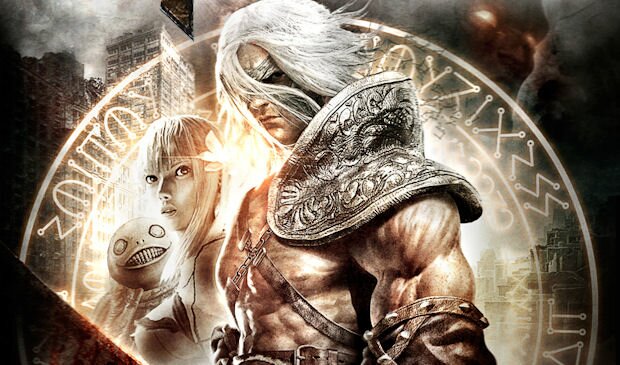

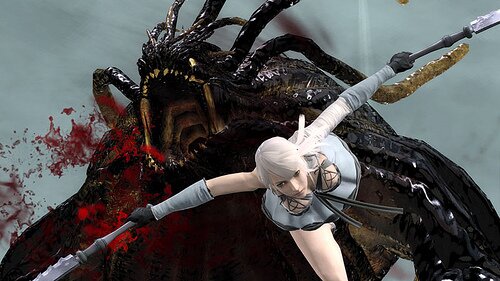
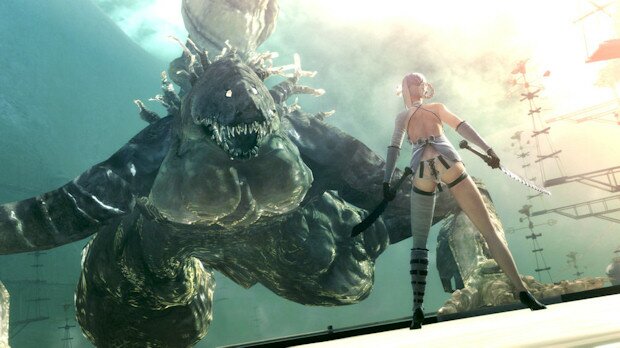
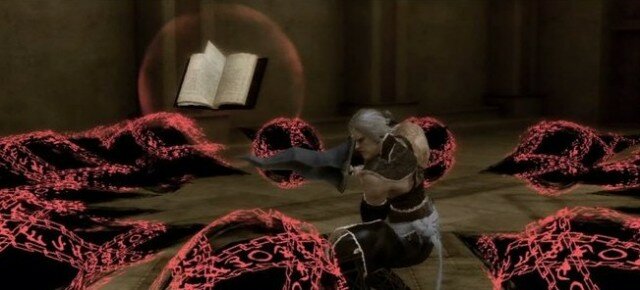
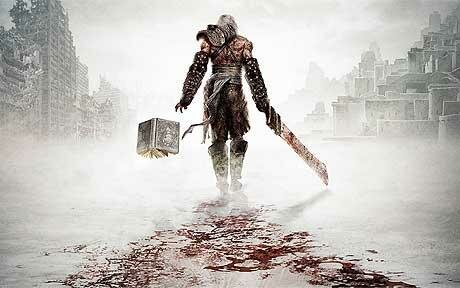
5 Comments
Awesome, awesome post about a criminally misunderstood game. To me, it’s almost a love-letter to the PS2 and the tropes of Japanese third-person action RPG design.
Also, I think it’s easy to confuse a clean, minimalistic graphical style as ‘rubbish’. I just thought it was alluding to the beautifully clean environments of Ico!
I think misunderstood is the best word to describe nier, and until i was pointed towards it i was a non-believer. I can really be too hard on those who don’t give it a chance, sadly games like this aren’t exactly big business.
Thanks for the comments it’s always nice to know people read what I write.
I dunno about “Beautifully clean”. There are jaggies everywhere. Again if the “Love letter to PS2 RPGs” thing is true, that makes sense, but when you look at Nier relative to all the other games, it just looks Lo-fi. Character models are nice though. Expect that was intentional.
Thank you for making so much sense. I don’t really remember how I heard about this game, it wasn’t from a friend or a television ad, but when I saw the way the game looked, not necessarily the graphical capability, but the art direction, I had to go out and buy it. I did get very frustrated with the fishing, but that is honestly the only gripe I’ve had so far. The story is so much better than so many other JRPGS, and the characters are so much more interesting. The newest Star Ocean title on the 360 made me want to kill myself pretty much the whole time I was playing it with its atrocious voice acting and boring as fuck story, and I just think it’s sad that gems like Nier get overshadowed just because they might seem a little flawed for someone who doesn’t have enough imagination to think that it could have been intentional. I seriously laughed out loud at the end of the Desert Dungeon.
I’m sad to see this article hasn’t gotten more comments. It was sometimes I quickly started to suspect about Nier and I’m glad someone can back me up.